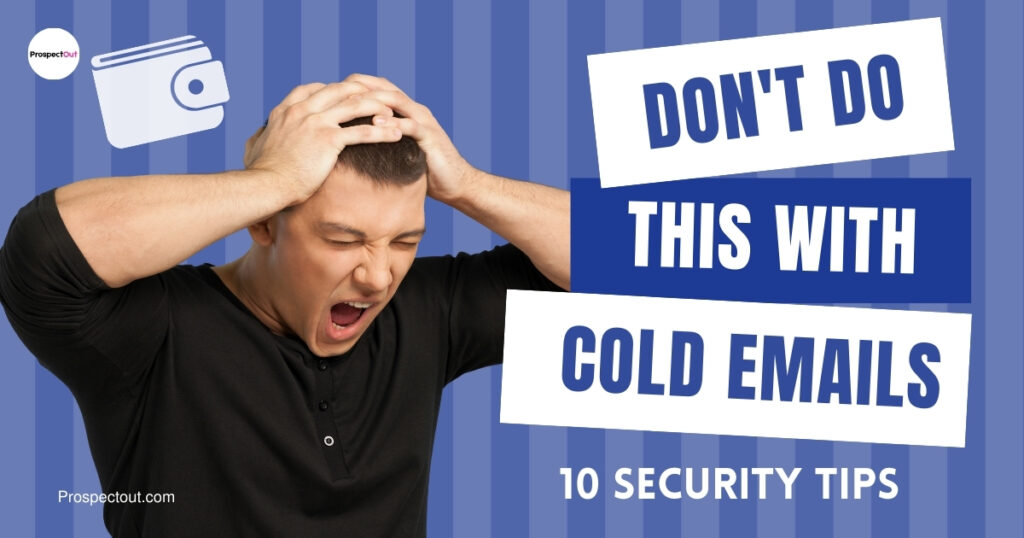Cold emailing is a powerful tool for lead generation,, but many campaigns fail due to common cold email mistakes. As a result, These mistakes severely impact open rates and replies, limiting your outreach success.
In this post, we’ll cover 10 critical cold email marketing mistakes to avoid so you can boost your open rates, get more replies, and land more meetings with potential clients.

Table of Contents
10 Cold Email Mistakes can kill your sales pipeline
1. Not Researching Your ICPs and Buyer Personas Properly
One of the most important cold email mistakes is not researching your buyer personas and ideal customer profiles (ICPs). Emails that lack a strong idea of who your prospects are will come across as unfocused and unproductive.
Take the time to identify your ideal customer profile (ICP), create a list of qualified leads, and craft emails that speak to their objectives and pain points. This strategy raises engagement and greatly raises the likelihood of setting up meetings.
Related: How Many Cold Emails to Get One Client
2. Sending Lengthy Cold Emails
Long emails quickly throw off busy prospects. While it’s tempting to explain all the ways you can help, lengthy emails often get ignored.
Cold emails should be brief and should aim to spark the reader’s curiosity instead of providing too much information. To improve your chances of receiving a response, try to convey the value in no more than 100 words. Keep your email concise, understandable, and interesting.
Related: Cold Email Strategy
Keep your emails concise—ideally under 100 words. Aim to pique curiosity rather than overwhelm the recipient with information.
3. Not Using the Right Tools for Cold Emails
Using the wrong tools for cold emailing can hinder your efforts. The right cold email tool helps automate your outreach, minimize mistakes, and optimize results. It saves time by reducing manual work, allowing you to focus on building strong relationships with prospects.
Right tools can streamline your process and significantly improve your cold email campaigns.
Related: Best Cold Email Software
By streamlining your workflow with these tools, you can focus more on crafting compelling emails and less on manual tasks
4. Not Segmenting Your Prospects
One common mistake that leads to low conversion rates is failing to segment your prospects properly. Without segmentation, your cold emails become generic, addressing broad pain points that may not resonate on a personal level.
Different prospects have unique challenges and priorities, so it’s crucial to group them based on factors like contract value, job titles, and goals. This allows you to craft personalized emails that speak directly to their needs, increasing open rates, replies, and booked meetings.
Related: Best Cold Email Frameworks 2024
By segmenting based on factors like job title or company size, you can better tailor your message and increase your chances of a positive response.
5. Not Warming Up Your Email Accounts
This is a most common mistake, skipping the email warm-up process, which is most important for building your sender reputation. Without proper warm-up, your emails may land in spam folders instead of inboxes.
Hurting your outreach efforts. Take at least three weeks to warm up new email accounts to improve deliverability and increase the chances of your emails being seen.
Automate the email warm-up process using a reliable tool for better efficiency.
Related: Send Bulk Cold Emails Without Getting Blacklisted
Warming up your email gradually builds your sender reputation, helping more of your emails land in your recipient’s inbox.
6. Using Primary Domains to Send Cold Emails
If recipients mark your cold emails as spam, sending them from your main domain could harm its reputation.
This could be harmful to regular business communication in addition to your cold outreach efforts. Keep your primary domain safe for customer communications and opt-in marketing.
Create backup domains that resemble your primary domain, especially for cold emailing. For example, to protect your company’s reputation, use alternatives like {your_company}.net, {your_company}.io or {your_company}.org.
Related: Is Sending Unsolicited Emails Legal?
7. Not Timing Your Emails Properly
Timing is essential when sending cold emails. If your email lands in a prospect’s inbox when they’re unavailable, it could easily be overlooked.
The best way to increase your open rates is to send emails during their work hours, typically on weekdays.
Be mindful of your prospect’s time zone and holidays to avoid wasted efforts. A well-timed email boosts the chances of it being noticed and opened, improving your overall campaign success.
Related: Best Time to Send an Email
Send your emails during typical work hours and consider your prospect’s time zone to maximize open rates.
8. Forgetting to Clean Your Email List
One major mistake in cold emailing is not regularly cleaning your prospect list. Over time, emails become outdated as people change jobs or companies.
Sending to invalid addresses can lead to high bounce rates, damaging your email reputation and deliverability. To avoid this, use an email verification tool to remove invalid addresses and keep your bounce rate low. Whether building or buying a list, always clean it to maintain optimal results.
Related: Cold Email Strategy
Use an email verification tool regularly to ensure that your list is clean and up to date.
9. Not Having a Proper Follow-up Plan in Place
A common mistake is sending just one cold email and waiting for a response. In reality, prospects are often busy and may overlook your message.
Follow-up emails serve as soft reminders, increasing your chances of getting noticed. Monitor your open rates. If emails are opened but not responded to, improve your messaging. Use follow-ups to provide value, such as case studies or new angles, to keep the conversation going.
Related: How Many Cold Emails to Get One Client
Always plan for multiple follow-ups to maximize your chances of getting a response
10. Using Multiple CTAs
Using multiple CTAs in a cold email can confuse your prospects, Leading to inaction.
A well-crafted CTA should clearly direct recipients to the next step, whether it’s booking a meeting, downloading a guide, or viewing a case study. Keep your focus on a single CTA to guide prospects effectively.
Related: Cold Email Strategy
Stick to a single, clear CTA that directs your prospect toward the next step.
How To Start Cold Emailing The Right Way?
- Define Your Goals: Know what you want to achieve with your cold email, whether booking a meeting or generating leads.
- Identify Your Target Audience: Understand who your ideal recipient is and tailor your email accordingly.
- Craft an Irresistible Subject Line: A compelling subject line grabs attention and encourages the recipient to open your email.
- Start with a Relevant Opening: Hook your reader with an opening that addresses their needs or interests.
- Introduce Yourself and Your Purpose: Briefly explain who you are and why you’re reaching out.
- Sympathize with Their Pain Points: Show that you understand the challenges they’re facing.
- Add Your Unique Value Proposition: Highlight how your solution can solve their problems or add value.
- Include a Clear & Direct Call-to-Action (CTA): Clearly state the next step you want the recipient to take.
- Close Your Email with Appreciation: End your email by thanking the recipient for their time.
- Don’t Forget Your Email Signature: Include your full name, title, and contact information to build credibility.
FAQ
What are common cold email mistakes to avoid?
Common mistakes include failing to research your target audience, sending overly long emails, neglecting to segment your prospects, not warming up your email accounts, and skipping follow-ups.
How can I increase response rates for my cold emails?
Improve response rates by personalizing your emails, keeping them concise, crafting compelling subject lines, segmenting your audience, and utilizing follow-up strategies.
Why is email segmentation crucial for cold outreach?
Segmenting your email list allows for targeted messaging, which enhances relevance and engagement, leading to higher open and response rates.
What tools should I use for effective cold email outreach?
Utilize email automation tools, CRM systems, and email verification services to streamline your outreach, enhance deliverability, and manage your contacts effectively.
How often should I follow up on my cold emails?
Follow up within one week of your initial email, with two to three follow-ups spaced a few days apart. Focus on adding value with each follow-up to maintain engagement.
Conclusion: Avoid These Cold Email Mistakes
For your cold campaigns to be successful, you must avoid common email mistakes. Craft messages that are value-driven, individualized, and have a single, compelling call to action.
You may improve engagement and boost your chances of building deep connections with prospects by refining these components.

